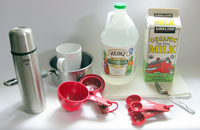Science in a Flash: Turn Milk into Plastic!
Try this quick and easy way to introduce kids to chemical reactions and polymers. One Science Buddies mom even used it for spur-of-the moment entertainment at a slumber party!

Simple household kitchen ingredients and materials let one science mom create a spur-of-the-moment science exploration for a group of early risers at a slumber party.
The kitchen chemistry science activity this mom did involves polymers. For another family science investigation of polymers, see "Putty Science: Family Fun with Polymers."
Got milk, vinegar, and twenty minutes? Then you can make plastic! Strange as it may sound in our era of petroleum-based plastics, up until about 1945, plastic made with casein (the protein found in milk) was very common. (If you have a knitter in the family, you may have even seen or used casein knitting needles.)
Plastic is a generic term for materials that can all be molded into many shapes. Plastics are all similar because they are all made up of molecules that are repeated over and over again in a chain, called a polymer. Polymers can be chains of one type of molecule, or chains of different types of molecules linked together in a regular pattern. When milk is heated and combined with an acid, such as vinegar, the casein molecules in milk unfold and reorganize into a long chain, a polymer. This polymer can be scooped up and molded, which is why plastic made from milk is called casein plastic.
Science to the Rescue!
Sherry Smith, Science Buddies Grants Manager and mom to 9-year-old Laura, didn't expect to be doing science projects at her daughter's slumber party. But when the girls woke up at 5:30 a.m., Sherry needed a fun activity to keep them occupied. Remembering Science Buddies' Turn Milk Into Plastic activity, she gathered the girls in the kitchen.
When Sherry described what they were going to do, the girls were immediately game. Says Sherry, "They are so used to arts and crafts projects, that I think the idea of a science project was much more exciting for them." That the "Turn Milk Into Plastic" chemistry investigation offers young scientists the chance for hands-on science and a creative and tangible take-away made it a great option for Sherry's sleepover contingent.
After gather the materials, Sherry heated a mug of milk for each girl and let them stir in the vinegar. The resulting chemical reaction created curds in the milk, evoking a chorus of "cool," along with one vehement "gross!" The girls noticed that one mug of milk and vinegar was producing far fewer curds than others—and enjoyed theorizing why. Most of the girls also liked squeezing the liquid out of the curds and shaping their plastic. The one who thought the curds were gross was able to participate by using her math skills when they wanted to increase the recipe by 50%. The polymer diagrams on the Science Buddies web site intrigued yet another of the early morning science crew.
Sherry loves that Science Buddies activities can engage kids who have a wide variety of interests, as happened at her slumber party. "In this case, one child didn't like curds but was proud that she could solve the math question."
Will Science Buddies be Invited to Next Year's Party?
Overall, slumber party kitchen science experiment was a big success for Sherry and her daughter. "The Science Buddies activity had much better results than store-bought science kits we've used in the past. The one mug that wasn't working was easily fixable and gave us way more to talk about. We learned a lot from the one that didn't work perfectly."
Will science be part of the entertainment at next year's party? It just might. And Sherry knows that with the help of Science Buddies, her kitchen supplies will be up to the task!
Science Buddies at Home and in the Classroom
Sherry used the Turn Milk Into Plastic activity, part of a series of family-friendly STEM activities on the Science Buddies website. There is also a Turn Milk into Plastic! lesson plan available for educators. Science Buddies Lesson Plans are NGSS-aligned and are written to help teachers facilitate hands-on classroom science exploration. The milk-based activity takes less than thirty minutes, including preparation! A full Project Idea related to this investigation, with in-depth background material and an experimental procedure, is available for independent student exploration.
Categories:
You Might Also Enjoy These Related Posts:
- 15 STEM Gifts & Science Kits You'll Feel Good About Giving
- 13 Boat Science and Submarine Science Projects and Experiments
- July 4th STEM! Summer Science Picks for Independence Day!
- 12 Science Kits for Summer Science Experiments and Discovery
- 15 Science Projects to Make and Give for Father's Day
- Ready, Set, Go! (Awesome Summer Science Experiments)
- Awesome Summer Science Experiments
- 10 STEM Activities with Cardboard Tubes









